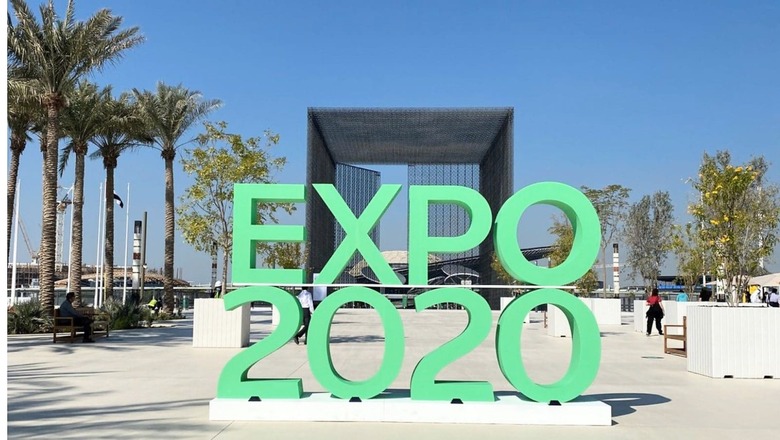
views
Amidst bright fireworks and brimming crowds, the World Expo 2020 in Dubai came to a picturesque culmination on 31 March 2022. This also drew curtains for the grand showing by India, which hosted one of the most-visited pavilions at this six-month-long international exhibition.
The idea of a world’s fair or expo is not new and has been around for more than a century. Following the 1928 Convention Relating to International Exhibitions, the Paris-based Bureau International des Expositions assumed the role of an international sanctioning body for such exhibitions. The Expo 2020, which was delayed by a year owing to the pandemic, was the biggest ever in more ways than one. Spread across a massive area of 1083 acres, it was a spectacular display of technological innovations, heritage, cultural performances and many other exhibits made by 192 nations’ pavilions that attracted travellers, students, businesspersons and government officials from across the world.
One of the most popular pavilions of all at the Expo was that of India, which recorded a footfall of over 1.7 million visitors. Spread over nearly one lakh square feet across four floors–each dedicated to a distinct theme–this state-of-art pavilion was a representation of India’s millennia-old heritage and her aspirations. There were eleven thematic focuses including climate and biodiversity, space, knowledge and learning, travel and connectivity, health and wellness, food agriculture and livelihoods, and water. Sixteen Indian states, ten central government ministries and over thirty corporate partners came together to project India’s achievements in twenty-eight sectors ranging from AYUSH to automobiles, handicrafts to healthcare and entertainment to the environment, across the eleven themes. Moreover, India’s participation in Expo 2020 was an endeavour to enhance our nation-branding, and in-turn our soft power.
The India Pavilion maximised this opportunity, from the unique architectural design of the pavilion all the way to inner exhibits, conferences and discussions, food festivals and performances. The pavilion, in particular, told three stories.
Wellbeing and Prosperity for the Entire Humankind
One, it conveyed our values and vision through two overarching themes. First, the attention drawn to Loka Samasta Sukhino Bhavantu reflected our civilizational ethos of wishing the well-being of all living beings. An extensive focus was laid on subjects of health, climate change and sustainability. Multiple conferences focusing on themes such as renewable energy, water conservation, and creativity and sustainability were organised by India. These events featured participation of subject matter experts and policymakers from India and other countries, coming together to address the most pressing livelihood and developmental challenges being faced across the world, and share lessons from their experiences. Furthermore, special attention was drawn to ushering demand-side interventions for the promotion of Indian-grown millets as a rich source of nutrition. With 2023 being declared as the International Year of Millets by the UN, Expo 2020 served as a platform to highlight investment opportunities and the potential of Indian millet-based enterprises to tap into global markets. Additionally, exhibits such as the Statue of Unity informed the visitors of our values of integration and pluralism.
The second dominant theme of the India pavilion was Openness. Opportunities. Growth, projecting India’s journey to becoming a USD 5 trillion economy. India’s growing external trade, success in the IT sector, burgeoning startup ecosystem, and increasing manufacturing prowess, position India as one of the fastest-growing economies in the world. Our achievements across various sectors—including automobile, aviation, steel, energy, IT, and outer space among others—were prominently showcased. An important highlight among the pavilion’s activities was the Elevate pitching sessions that involved participation of over 700 startups, many of which secured notable investments. Startups also engaged with visitors through another interactive platform of the India Innovation Hub.
A Display of Culture, Creativity and Conviviality
Each floor of the pavilion was curated to showcase the connection between the past, present and future. Replicas of heritage sites were recreated to familiarise visitors with some of our civilisational marvels across India. This included Rani ki Vav in Gujarat to the Konark Sun Temple in Odisha, and the Ram Mandir and Kashi Vishwanath in Uttar Pradesh to numerous others.
Besides these tangible representations, cultural performances by classical and folk artists from India, the celebration of festivals including Diwali and Holi, food festivals and regional cuisine outlets, and immersive workshops were also organised. A dedicated section to Yoga and Ayurveda drew attention to India’s oldest and one of the most flourishing cultural gifts to the world. The Indian AYUSH market stands at USD 10 billion, and India is perhaps the only country having a dedicated national government ministry for traditional healing systems.
Furthermore, a national film festival, seminars and discussions on creative industries and the promotion of many Indian movies at the pavilion reiterated the popular appeal of the Indian film industry, which is also the largest in the world. The fast-growing media and entertainment industry is valued at USD 28 billion and is projected to touch USD 100 billion by 2030. In addition to this, participating Indian states and UTs from Jammu and Kashmir to Jharkhand to Tamil Nadu were given a week to project their tourism potential, culinary and cultural traditions, natural landscapes, and investment opportunities, thus encouraging inbound travel into India.
Meanwhile, a section dedicated to India-UAE relations illustrated the unique friendship between the two countries. The UAE is not only home to the third-largest Indian diaspora community in the world, but also an increasingly important strategic and economic partner. Even as the major milestones in the bilateral relationship were being displayed at the India Pavilion, the two countries very fittingly concluded the historic trade pact CEPA, which is expected to take their ties to newer heights.
India On the Move
The very architectural design of the India Pavilion building created a technology-centered experience for visitors, symbolising the theme ‘India On The Move’. Commemorating the 75th anniversary of India’s independence from colonial rule, the outer wall of the pavilion was festooned with 600 kinetic blocks that rotated to project 75 stories of India’s culture, history, achievements, and aspirations. In the evening, the outer facade turned into a splendid light and sound show, all achieved through high-end digital technologies. The pavilion was recognised by the Exhibitor Group, among the top three in the Peoples’ Choice category, for its design and innovation.
Inside the pavilion, India’s growth and opportunities in various sectors, including outer space, were detailed through exhibits as well as augmented reality experiences. Large LCD screens showcased Indian textiles, travel destinations, festivals, art traditions, the film industry and much more, all powered by state-of-the-art digital visualisations.
Overall, the India Pavilion has proved to be a great messenger of the India story to the world, particularly at a time when India has begun to reignite its growth engines in a post-pandemic world. Concomitantly, it has provided yet another shot in the arm for the India-UAE friendship, which as Commerce Minister Piyush Goyal recently put it, is the envy of many parts of the world.
Arunima Gupta is a scholar of soft power and creative economy. She is an alumna of Leiden University and Lady Shri Ram College for Women. She tweets at @ArunimaGupta03. Kamal Madishetty is a foreign policy analyst who is pursuing a PhD in International Politics at the Jawaharlal Nehru University. He tweets at @KamalMadishetty. The views expressed in this article are those of the authors and do not represent the stand of this publication.
Read all the Latest Opinion News and Breaking News here




















Comments
0 comment